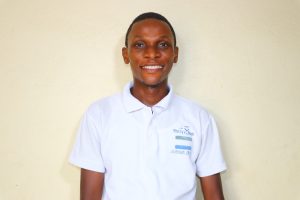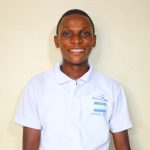In the Kambia Worreh Community, 71 residents' only water source is a swamp, which is unfit for consumption. They have no other option than to travel long distances and use the water, which is impeding their daily lives.

The current water source.
15-year-old Warrah spends four hours a day collecting water from the swamp. That's four hours not spent in class or playing with her friends.

Warrah collecting water.
When asked why collecting water consumes so much of her time, she said, "Long walking distance to the swamp water source. This makes me delay, especially when I have a lot of trips to do for the day. There are times when the water changes its color easily. This causes me to delay because I must wait patiently for the water to clear before fetching it from the swamp. There are also instances in which the swamp gets overcrowded, especially on Saturdays. This is because a lot of people will go to this source to fetch water for laundering. This situation prevents me from fetching water on time."
With no solution in sight, Warrah shared, "I feel discouraged because I will not be able to fetch the water I need. This made me go to the neighboring communities just to fetch water so that I would be able to carry it home."

Warrah and community members make the trek home.
One of the most devastating effects of this community's water crisis is on Warrah's education. Searching for and carrying heavy loads of water saps energy and time that should be spent on her education.
"In a world where education for girls is already a bigger challenge, a water crisis makes it even harder. According to the UN Women: “In 80 per cent of households with water shortages, women and girls are responsible for water collection. This often means travelling long distances and carrying heavy loads, in some cases with a high risk of violence. The time required can pull girls out of school and leave women with fewer options to earn an income.” - UN Women

Warrah collecting water.
"Most times, I will fetch water before going to school. By the time I get to school, I would be late. There was a time during my exams [when] I came late to school. I met my friends already through writing the exam paper. I failed the paper because I had limited time to complete it. All this occurred due to the water constraint in the community," added Warrah.
Installing a well in the Kambia Worreh community will allow children like Warrah to spend more time in school and not have to worry about distant journeys carrying heavy containers of water multiple times a day. Warrah has big dreams, and with accessible clean water, she will be one step closer to achieving them!
"I want to be a medical doctor with God being my helper," she concluded.
Steps Toward a Solution
Our technical experts worked with the local community to identify the most effective solution to their water crisis. They decided to drill a borehole well, construct a platform for the well, and attach a hand pump.
Well
Abundant water often lies just beneath our feet. Aquifers—natural underground rivers—flow through layers of sediment and rock, offering a constant supply of safe water. A borehole well is drilled deep into the earth to access this naturally filtered and protected water. We penetrate meters, sometimes even hundreds of meters, of soil, silt, rock, and more to reach the water underground. Once found, we construct a platform for the well and attach a hand pump. The community gains a safe, enclosed water source capable of providing approximately five gallons of water per minute. Learn more here!
Community Education & Ownership
Hygiene and sanitation training are integral to our water projects. Training is tailored to each community's specific needs and includes key topics such as proper water handling, improved hygiene practices, disease transmission prevention, and care of the new water point. Safe water and improved hygiene habits foster a healthier future for everyone in the community. Encouraged and supported by the guidance of our team, a water user committee representative of the community's diverse members assumes responsibility for maintaining the water point, often gathering fees to ensure its upkeep.

 Borehole Well and Hand Pump
Borehole Well and Hand Pump
 Rehabilitation Project
Rehabilitation Project














